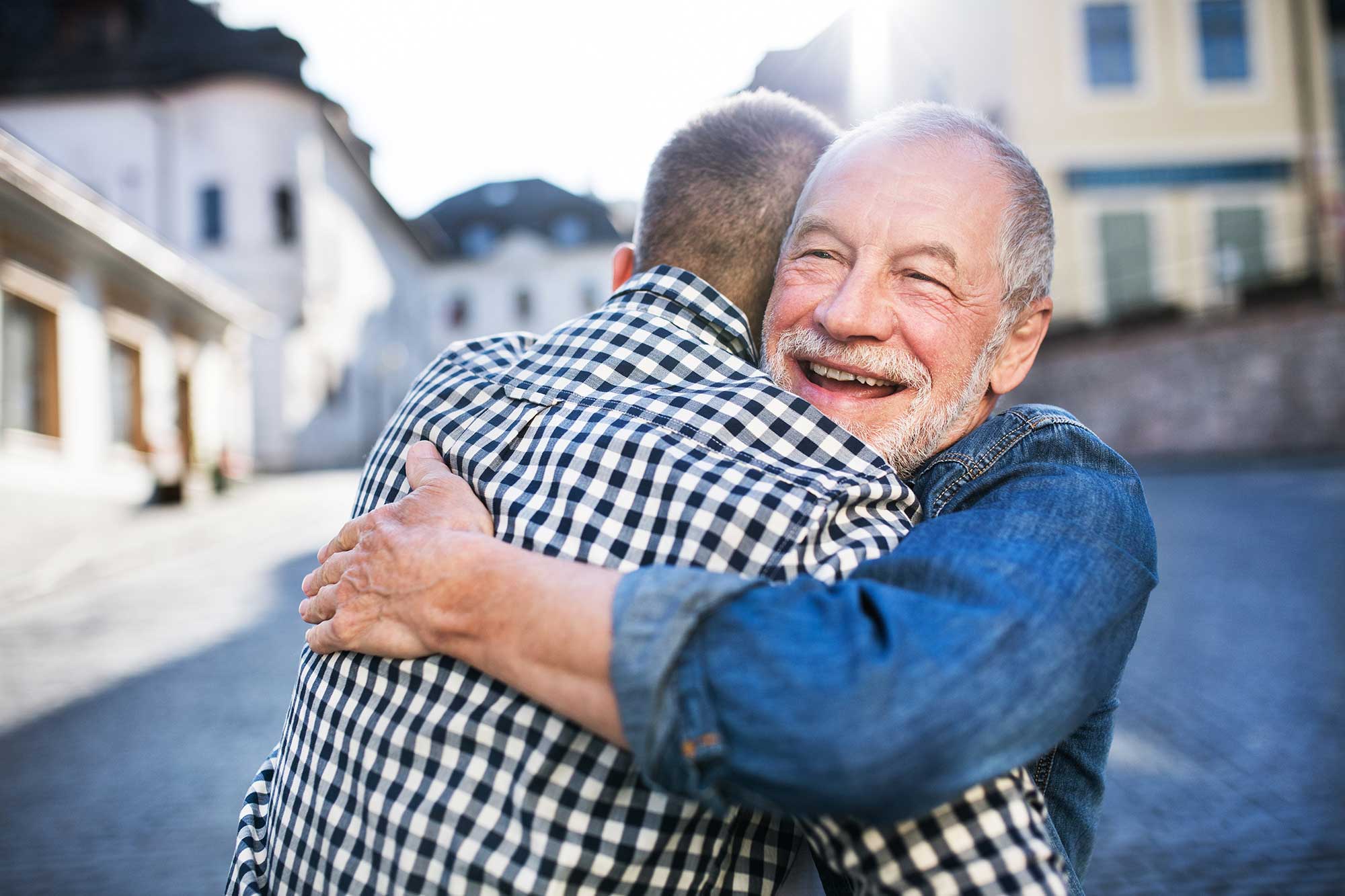Grief Basics
The days, weeks and months that follow the death of a loved one can sometimes be surprisingly difficult. Coping with the losses and challenges associated with the death of a loved one can feel akin to being routed miles off the Interstate and into unfamiliar territory without a map.
We believe that just as a good map could be quite useful on an unexpected road detour, having a “map” as you enter the territory of grief and loss can be very beneficial as well. While everyone’s grief experience will be uniquely personal, knowing what the “territory of loss and grief” looks like can be very reassuring. Much unnecessary suffering can be prevented through accurate information and realistic expectations.
Resources for Grief
Click on the articles below designed to provide you and your family with helpful information about various aspects of the grieving process.
- A Bill of Rights for Grieving People
- Grief 101: A Basic Primer
- The Experience of Grief: More Than Feelings
- How We Grieve: Understanding Differences
- When Will the Grief Get Easier?
- Setting Appropriate Expectations
- Is There a Timeline for Grief?
- What Others Need to Know
- Signs of Healing
- The Rest of the Journey

A Bill of Rights for Grieving People
You have the right to grieve in your own way and at your own pace. Although grieving people may find many commonalities with one another, no two people grieve in exactly the same way or at the same speed. No one can tell you how you “should” grieve or at what pace.
You have the right to whatever grief emotions you are feeling. Sadness, anxiety, anger, confusion, relief and guilt can all be part of the grief experience.
You have the right to cry without apologies. We seem to be hard-wired for tears as a way of releasing and expressing pent-up emotions.
You have the right to talk about your grief as well as the right not to talk about your grief. Talking can be very healing, but you do have the right to choose what and with whom you want to share.
You have the right to treasure your memories, stories and relationship with your loved one.
You have the right to be honest when asked about how you are doing.
You have the right to take care of yourself and do what is right for you. You can rest, slow down and choose which invitations you want to accept and which you choose to decline.
You have the right to do things differently. You can change the furniture around, eat at different times, revise or let go of “traditions” for the time being – or forever.
You have the right to laugh and enjoy life. Joy can be present in the midst of sorrow just as sorrow can be present in times of joy and celebration. Allowing your attention to be directed into the moment and away from sorrow does not mean you have forgotten your loved one.
You have the right to express, nurture or explore your spirituality. Grief can be a catalyst for spiritual growth. Sometimes loss can leave us questioning our beliefs and assumptions. This process, though at times uncomfortable, may lead you to a deeper and more meaningful spirituality.
“There is sacredness in tears. They are not the mark of weakness, but of power. They speak more eloquently than ten thousand tongues. They are the messengers of overwhelming grief … and unspeakable love.”
— Washington Irving
Grief 101: A BASIC PRIMER
Bereavement means that we are deprived, robbed or stripped of someone or something of high personal value. In other words, it’s the objective state of having suffered a loss.
Grief refers to our internal and external reactions to loss.
Mourning is the way in which we express our grief.
Grief is a natural response to loss and a normal consequence of our ability to love, connect and live fully. We do not grieve that which isn’t important to us. It is the link between loss and moving forward.
Grief is experienced at multiple levels. It affects us physically as well as emotionally and spiritually and impacts our thinking and behavior.
There is no one right way to grieve. Response to loss is highly individual, based on personality, life experience, personal beliefs and expectations, as well as other factors unique to the individual and their relationship with whom or what is lost. Everyone grieves in his or her own way.
Grief can be exhausting. The energy that grief requires takes its toll in fatigue, irritability and forgetfulness. Attention to the basics of self-care — health, nutrition, rest and exercise — facilitates the healing process.
Fluctuation in feelings, energy and coping is to be expected. The ups and downs are often unpredictable and are a normal part of the grief experience.
There is no timetable for grief. It takes as long as it takes. While the intense pain that often accompanies acute grief may be expected to abate over time, there will always be times when the loss is remembered, missed and grieved.
Children do grieve, although they express it differently than adults. Their reaction to loss and understanding will differ according to age and development. Age appropriate information about death and grief coupled with sensitive support can help.
Knowing that there are wide variations in what is “normal” can help. Inaccurate or faulty information about the grieving process leads to unrealistic expectations, which can unnecessarily add to pain and suffering.
Grief impacts not only the individuals directly involved, but also their social connections and support system. Relationships are changed after loss, and it is normal to reassess, change or even end some relationships.
Grieving people sometimes need to look outside their usual support system to find the understanding and information they need. Grief or other support groups, books, internet resources and professional counseling can be of benefit.

The Experience of Grief: More Than Feelings
The personal impact of loss can be wide-ranging. Grief is expressed not only through feelings, but also through physical sensations, thoughts or cognitions, changes in behavior. While everyone grieves in their own way, there are some common experiences that many bereaved people normally experience. Although these experiences may be grief related, it is very important the griever have a complete physical exam to rule out other causes of such symptoms.
What you may experience physically:
- Physical pain
- Physical exhaustion
- Tightness in the throat and/or muscles
- Heaviness or pressure in the chest n Lack of energy
- Hollowness in the stomach
- Breathlessness
- Heart palpitations
- Weight loss or gain
- Periods of nervousness or even panic
- Hyper-sensitivity to noise
- Digestive disturbances
- Loss of sexual desire or hyper-sexuality
- Susceptibility to physical illnesses
What you may experience emotionally:
- Shock/numbness
- Denial
- Sadness
- Anger/fear
- Guilt
- Relief
- Anxiety
- Mood swings
- Loneliness
What you may experience behaviorally:
- Tearfulness
- Sleep disturbances
- Appetite changes
- Restlessness
- Withdrawal/isolation
- Vivid dreams of loved ones
- Searching
- Avoiding reminders of loved one
- Procrastination
- Desire to run away or become very busy to avoid the pain of loss
What you may experience cognitively:
- Forgetfulness
- Losing things
- Confusion
- Difficulty concentrating
- Auditory/visual hallucinations
- Difficulty processing information n Fearing losing control
- Recurring memories
What you may experience spiritually:
- Search for meaning
- Crisis of faith
- Confirmation of faith
- Anger at God
- Concerns about afterlife
- Guilt/forgiveness
“Grief is not a disorder, a disease or a sign of weakness. It is an emotional, physical and spiritual necessity, the price you pay for love. the only cure for grief is to grieve.”
— Earl Grollman
How We Grieve: Understanding Differences
How do we know how deeply someone is grieving? Because not everyone grieves in the same way, it is sometimes difficult to understand a grieving heart, especially when the more obvious emotional signs of grief seem to be absent. If we assume that grief always presents itself in certain ways, we may incorrectly assume that the absence of particular behaviors indicates an absence of grief or a lack of feeling.
How a particular person grieves is determined by a host of factors specific to that individual. Prior experiences with loss, age, gender, coping abilities, spiritual belief system and cultural conditioning are but a few of the many factors that influence how any one person will react to the loss of a loved one. Those individual factors are as unique as our fingerprints, so it should come as no surprise that grieving individuals may appear very dissimilar in how they respond to loss.
Experience and research with bereaved individuals suggests that there are two general styles of grieving. For individuals who are INTUITIVE grievers, grief is an openly emotional experience. These people may struggle with emotions that always seem too close to the surface; they are open to talking about their loss and physically appear to be saddened and de-energized. INSTRUMENTAL grievers are people who process their loss through activity, and thinking through their loss experience. They often feel as emotionally wounded as their intuitive counterparts, but their pain is much less obvious to the casual observer.
These styles exist along a continuum. Most of us lean toward one pole or the other of the continuum with very few individuals relying completely on one or the other style. In any given family you are likely to see both styles of grieving—one sibling may require physical comforting and lots of interpersonal support, while another sibling may cope by taking charge of tasks related to the loss and appear reticent to acknowledge their feelings.
Neither style is ‘better” than the other. When we can recognize and respect the differences, we are better able to support one another through the territory of loss.

When Will the Grief Get Easier?
In the early days of the grief process, many grievers begin to think there will never be relief from the intense, unremitting symptoms of grief. Sleep may be disrupted, draining away your energy, motivation and desire. Concentrating on the simplest of tasks may sometimes seem beyond ability. Longing, loneliness and sadness feel like constant companions. As the days go by, other people in your life may express concern over the continued intensity of your grief and may gently suggest it is time to “move on.” You may begin to wonder if your grief is normal.
It is important to recognize that what is “normal” varies widely among individuals. But generally, while intense emotional, physical and cognitive reactions are very normal in the early stages of grief, as time goes on, the griever usually finds such reactions decreasing in both intensity and frequency. Grief often intensifies two to three months after the loss and again before the first anniversary. Special days and events can trigger grief for years to come. Also common are sudden, unexpected surges of grief around such things as hearing a special song or spotting a favorite restaurant. The griever gains experience in dealing with upsurges in acute grief in healthy ways that allow the activities of daily life to continue without too much disruption.
Looking for small signs of healing can be helpful. Perhaps you find yourself laughing more or you begin looking forward to future events and plans for the future. For most grieving people, healing occurs. Holding on to that hope and looking for small signs of healing can bring comfort during the heavy days of early grief.
“Patience will serve you well as you experience your grief and mourning … our society is constantly trying to speed up our grief.”
— Alan D. Wolfelt, Ph.D., Healing Your Grieving Heart: 100 Practical Ideas
Setting Appropriate Expectations
Each person’s journey through grief is unique, personal and painful. In an effort to “speed up” the grief process, many grievers will put unnecessary pressure and expectations on themselves. Others may add additional pressure, mistakenly assuming that the bereaved “should” be further along in their grief. Appropriate expectations, such as the following, can normalize the grief journey and help in the healing process.
- Your grief will take longer than most people think.
- Your grief will take more energy than you would have ever imagined.
- Your grief will involve many changes and be continually developing.
- Your grief will depend upon how you perceive the loss.
- You will grieve for many things both symbolic and tangible, not just the death alone.
- You will grieve for what you have lost already and for what you have lost for the future.
- Your grief will entail mourning not only for the actual person you lost but also for all of the hopes dreams and unfulfilled expectations you held for and with that person, and for the needs that will go unmet because of the death.
- The loss will resurrect old issues, feelings and unresolved conflicts from the past.
- You will have some identity confusion as a result of this major loss and the fact that you are experiencing reactions that may be quite different than what you expected.
- You may have a lack of self-concern.
- You may experience grief spasms, acute upsurges of grief that occur suddenly with no warning.
- You may feel as if you are going crazy.
- You may be obsessed with the death and preoccupied with the deceased.
- You may find yourself acting socially in ways that are different than before. You may find that there are certain dates, events and stimuli that bring upsurges in grief.
- Others will have unrealistic expectations about your mourning and may respond inappropriately to you.
- Certain experiences later in life may temporarily resurrect intense grief.

Is There a Timeline for Grief?
Most people like the idea of predictability, especially when there is pain involved. We want to know when the pain of a root canal will subside, when we can return to work after a minor surgery, when we can start running again after a pulled muscle. Predictability helps to calm. When will I be better?
However, we know the pain of losing a loved one is different. We are aware that this pain is going to be with us throughout our lifetime. Many of us welcome the lingering pain in some form as a testament to how much our loved one mattered to us. The grief journey is not a sprint to a finish line somewhere out in the future. It is more like a roller coaster with ups and downs, which tend to lessen as time goes on.
Typically, in the first weeks of the loss, there is a sense of numbness. There is a robot quality to the griever, who is going through the motions of getting through funerals or memorial services and taking care of necessary business. The three C’s – cards, casseroles and calls – are usually in abundance.
Grief, although at times intense, can seem to be somewhat manageable. Then, for a surprising percentage of people, the bottom drops out around the two-month mark after the death. The support begins to drop away as people go back to their normal lives.
Then, the griever begins to realize there is no going back and this is now their “new normal”. The grief waves hit in a ferocious intensity. The griever may be blindsided. They thought they had been doing so well and are now struggling with intense waves of emotions. Many will become fearful, thinking, “Am I going crazy?” However, as they persevere through these intense months of grief, most start seeing small windows of relief after a few months.
Healing comes slowly and is interrupted regularly by “grief ambushes.” Overall, the griever will begin to see small signs of healing as the first year progresses. As the first anniversary approaches, one may find themselves in the intense grief that they experienced earlier in the grief process, but many find that once the first anniversary passes, the slow signs of healing begin to present itself once again.
The grief journey is different for every griever, as every loss and every person are different. However, knowing the general patterns of grief may help during the difficult early months of the journey.
“Grieving is a necessary passage and a difficult transition to finally letting go of sorrow – it is not a permanent rest stop.”
— Dodinsky
What Others Need to Know
Please do:
- Listen 80 percent of the time and talk 20 percent of the time.
- Allow the mourner to talk about their loss.
- Accept their tears.
- Talk about your losses and what helped you adapt.
- Use appropriate physical contact.
- Be patient with the griever’s story.
- Use the deceased’s name.
- Offer specific help.
Please don’t:
- Force the mourner to put on a happy face by saying “You’re doing so well.”
- Tell the mourner what they “should” do.
- Say “Call me if you need anything.”
- Delegate others to help.
- Say “I know how you feel.”
- Use abrasive consolation, by saying “There are other fish in the sea,” or “God works in mysterious ways.”
- Try to hurry people through their grief by pressuring them to get busy or give away a loved one’s possessions. Their grief must be done on their schedule, not yours.

Signs of Healing
Grieving people are often fearful that the intense pain of early grief will never abate. Pain, whether emotional or physical, focuses attention on itself, causing us to overlook the signs that healing is proceeding, despite the presence of pain and sorrow. Like the “hidden pictures” in a child’s puzzle book, when you know what to look for, it becomes easy to see what was right in front of your eyes. A few of these signs include:
- You realize that the time spent crying is decreasing.
- You become aware that your physical energy is slowly returning.
- You recognize that you can remember what you just read.
- You can concentrate on something other than your loved one for longer periods of time.
- Your appetite starts to return.
- You can laugh at a good joke.
- You realize that you are sleeping a little better.
- You feel comforted by sharing memories with others.
- You realize that you are no longer crying every time you hear or speak your loved one’s name.
- You can reach out to help another person.
- You feel less need to visit the cemetery.
- You notice a decrease in the feelings of fear and anxiety.
- You recognize that you don’t have to hold on to the pain as a way of staying emotionally connected to your loved one.
- You can experience a memory that warms your heart.
- You are able to take pride in your success at meeting new challenges.
- You are more willing to visit the grave site when it had previously been too hard to go.
- You can forget the loss for a short time without feeling as if you are betraying your loved one.
- You can enjoy the small pleasures of life — a sunny day, a beautiful sunset or time with friends or family, without feeling guilty.
- You begin looking forward to future events and plans for the future.
“Hope smiles from the threshold of the year to come whispering ‘it will be happier’.”
— Alfred Lord Tennyson
The Rest of the Journey
You may be asking yourself, “Where do I go from here?” That’s not an easy question to answer when you have been grieving the loss of your loved one. Things have changed. You were the one who had everything together. You were the one who took the reigns and made sure all tasks were covered and everybody had what they needed. You made sure all the ‘I’s were dotted and all the ‘T’s crossed. Now, you are trying to figure out a way to move forward.
Are you ready to experience life the way you have always wanted things to be? In this article, I will explain how you may establish a plan that provides you with hope and encouragement for the rest of the journey.
You’re at a new place in your life and you want to change the script. You are depleted of all the tears you have needed to shed after the passing of your loved one. Today is a new day. Let’s get you moving forward. A ray of sunshine will ignite your path and give light to that side of you that has laid dormant for quite some time. So, grab a piece of paper, a pen, and a cup of coffee or tea because your moment to be in the spotlight is now!
First, write down all the things you like to do, which include hobbies, skills and adventures. Some people like to read, cook, paint or garden. Maybe you have always wanted to take classes in an area of interest to you. It’s time to change your thoughts from saying “I can’t!” to “I can!”
Be mindful that this list does not have to be completed. You have plenty of time, and you will add to the list as you think of more things you will want to try or revisit again.
This new journey is about your self-care. It is an area many people feel guilty about tapping into. Often, we don’t see the need to gift ourselves but we give out to so many without looking for a return. In his book “Understanding Your Grief: Ten Essential Touchstones for Finding Hope and Healing Your Heart,” Dr. Allen Wolfelt shares that good self-care is essential to survival.
“Practicing good self-care doesn’t mean you are feeling sorry for yourself, being selfish, or being self-indulgent; rather, it means you are creating conditions that allow you to integrate the death of someone loved into your heart and soul,” Wolfelt writes.
Growing past our grief is not forgetting about our loved one that died but trusting the process that your loved one would want you to carry on by discovering the new you.
Next, what are your greatest fears? Write them down in a journal and describe what that feels like to you. Then take a breath or two — it’s all going to be OK. We all have something we fear. But when you realize that the journey through our fears opens the door to new opportunities, you will grow into the excitement that awaits on the other side.
Wolfelt writes, “Remember ― self-care fortifies your long and challenging grief journey, a journey which leaves you profoundly affected and deeply changed. When we recognize that self-care begins with ourselves, we no longer think of those around us as being totally responsible for our well-being.”
Walking through that long-awaited door brings you the hope that has been missing for a while. You will start to see things differently. Hope invites in new ideas that have always been there with you, but those ideas have been buried under the weight of grief. As you are journaling, let the list nourish and enrich your soul.
In their book “Finding Hope: Ways to See Life in a Brighter Light,” Ronna Jevne and James Miller explain hope. They write: “A wonderful thing about hope is that it’s all over the place. You don’t have to manufacture it — it’s already present. Often you don’t have to search for it — all you have to do is look in its direction. It’s just as evident in the simple as in the grand, in the nearby as in the faraway.”
When you are just starting out on your path through grief and your journey forward, invite one, two, or maybe a crowd of close friends to have a meal with. It’s never out of the ordinary to feel that your social life has been placed on the back burner. Socializing with others encourages our hope for a bright future to meet you where you are. Your friends and loved ones care about you and encourage your growth. That is what hope does on our path for the rest of the journey.
I hope this article has opened your eyes to see what the brand new you will begin to look like. Don’t let another day go by without tapping into what you can do today. It’s not about what you are doing already, but what you haven’t done is what hurts the most. You have grieved well and have found that special place in your heart for your loved one. So, go forward and treat yourself to the future you deserve for the rest of the journey.

